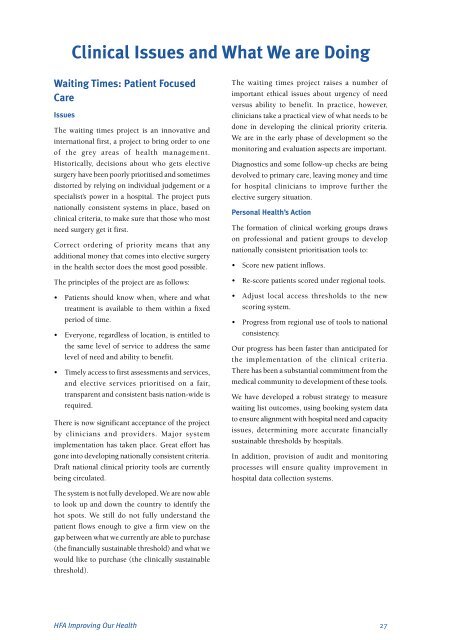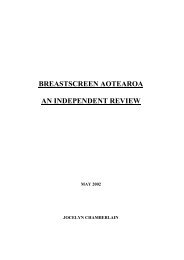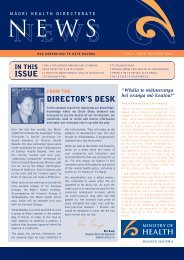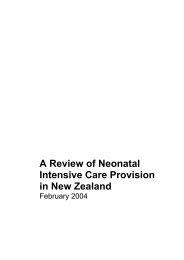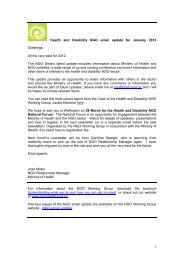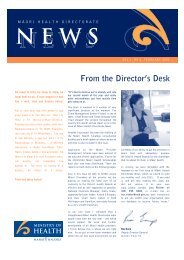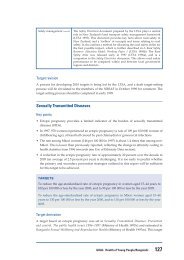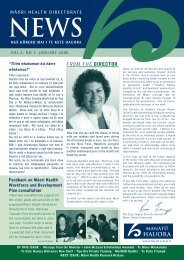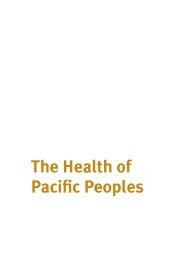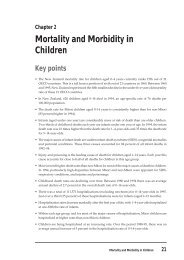Document for PDF - Ministry of Health
Document for PDF - Ministry of Health
Document for PDF - Ministry of Health
Create successful ePaper yourself
Turn your PDF publications into a flip-book with our unique Google optimized e-Paper software.
Clinical Issues and What We are Doing<br />
Waiting Times: Patient Focused<br />
Care<br />
Issues<br />
The waiting times project is an innovative and<br />
international first, a project to bring order to one<br />
<strong>of</strong> the grey areas <strong>of</strong> health management.<br />
Historically, decisions about who gets elective<br />
surgery have been poorly prioritised and sometimes<br />
distorted by relying on individual judgement or a<br />
specialist’s power in a hospital. The project puts<br />
nationally consistent systems in place, based on<br />
clinical criteria, to make sure that those who most<br />
need surgery get it first.<br />
Correct ordering <strong>of</strong> priority means that any<br />
additional money that comes into elective surgery<br />
in the health sector does the most good possible.<br />
The principles <strong>of</strong> the project are as follows:<br />
• Patients should know when, where and what<br />
treatment is available to them within a fixed<br />
period <strong>of</strong> time.<br />
• Everyone, regardless <strong>of</strong> location, is entitled to<br />
the same level <strong>of</strong> service to address the same<br />
level <strong>of</strong> need and ability to benefit.<br />
• Timely access to first assessments and services,<br />
and elective services prioritised on a fair,<br />
transparent and consistent basis nation-wide is<br />
required.<br />
There is now significant acceptance <strong>of</strong> the project<br />
by clinicians and providers. Major system<br />
implementation has taken place. Great ef<strong>for</strong>t has<br />
gone into developing nationally consistent criteria.<br />
Draft national clinical priority tools are currently<br />
being circulated.<br />
The waiting times project raises a number <strong>of</strong><br />
important ethical issues about urgency <strong>of</strong> need<br />
versus ability to benefit. In practice, however,<br />
clinicians take a practical view <strong>of</strong> what needs to be<br />
done in developing the clinical priority criteria.<br />
We are in the early phase <strong>of</strong> development so the<br />
monitoring and evaluation aspects are important.<br />
Diagnostics and some follow-up checks are being<br />
devolved to primary care, leaving money and time<br />
<strong>for</strong> hospital clinicians to improve further the<br />
elective surgery situation.<br />
Personal <strong>Health</strong>’s Action<br />
The <strong>for</strong>mation <strong>of</strong> clinical working groups draws<br />
on pr<strong>of</strong>essional and patient groups to develop<br />
nationally consistent prioritisation tools to:<br />
• Score new patient inflows.<br />
• Re-score patients scored under regional tools.<br />
• Adjust local access thresholds to the new<br />
scoring system.<br />
• Progress from regional use <strong>of</strong> tools to national<br />
consistency.<br />
Our progress has been faster than anticipated <strong>for</strong><br />
the implementation <strong>of</strong> the clinical criteria.<br />
There has been a substantial commitment from the<br />
medical community to development <strong>of</strong> these tools.<br />
We have developed a robust strategy to measure<br />
waiting list outcomes, using booking system data<br />
to ensure alignment with hospital need and capacity<br />
issues, determining more accurate financially<br />
sustainable thresholds by hospitals.<br />
In addition, provision <strong>of</strong> audit and monitoring<br />
processes will ensure quality improvement in<br />
hospital data collection systems.<br />
The system is not fully developed. We are now able<br />
to look up and down the country to identify the<br />
hot spots. We still do not fully understand the<br />
patient flows enough to give a firm view on the<br />
gap between what we currently are able to purchase<br />
(the financially sustainable threshold) and what we<br />
would like to purchase (the clinically sustainable<br />
threshold).<br />
HFA Improving Our <strong>Health</strong> 27


